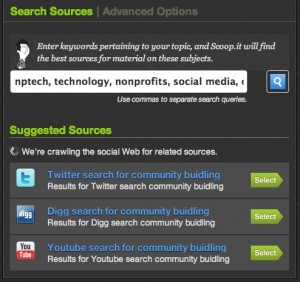For over a year now, I’ve been moderating and facilitating a monthly online discussion for people working as community builders and for those looking for feedback on community building efforts. It’s called the #CommBuild chat and was born out of a facilitated monthly Twitter chat called #4change. Often in these chats, participants discuss the online tools they are using and new platform functionality, all with the hope of finding ways to increase community engagement. For example, this month’s online chat, normally coordinated via the text chat platform CoverItLive, tried out a new platform, Google+ Hangout. This video chat application is part of Google+ and allows up to 10 video participants to come together—great for #CommBuild participants because they get real face time with each other.
So when Scoop.it, a new content curation platform, hit the web recently, the #CommBuild network seemed like the perfect place to try it out.
Whether you’re interested in community building, hot air ballooning, or the way robots work, you’re never going to be the only person talking about it online. In fact, the web is so full of information that many organizations are finding it useful to pull together topic-specific content on the web and make it available in one place. These can be useful internally and externally—you can share news with colleagues or create a dashboard of resources for your community. Scoop.it positions every user as a content curator. Unlike a blog, which positions us all as topic experts with a soapbox of our own, Scoop.it makes it possible to pull together media of all kinds—blogs, news, videos, etc.—from many different resources.
How It Works
Are you enjoying this article? Read more like this, plus SSIR's full archive of content, when you subscribe.
Scoop.it has an impressively intuitive interface for just being in a beta launch. You pick your topic, add a description of the collection, then you can begin searching for relevant articles and other media to include. Scoop.it provides automated searches to match all the keywords you include on your topic—check out the image below to see automated searches on Digg, Twitter, and Youtube.

You can “scoop” content (add it to your topic page) from the Scoop.it dashboard. You can also browse the web and “scoop” up content about your topic using a bookmark (when you join, you can follow steps to add the Scoop.it button to your bookmarks bar). Once you’ve added information to your topic, you’ll want to share it. Every time you add a piece of content to your page, you have the option of sharing the link to your page via Facebook, Twitter, and Google+.
For the CommBuild topic, I used Scoop.it’s built-in search feature to add news articles and blog posts to my page—they show up as suggested content, and you can click to dismiss or add to your page. Once I put a handful of items on my page, I clicked Share and tweeted that I’d created the topic to my network. Just like that, it was out there. I then opened Tweetdeck, a desktop application for managing Twitter and other social platforms, and watched the stream of content from Twitter flowing by. As I saw links of interest—especially ones shared by the #CommBuild community, I added them to the Scoop.it page by clicking on the bookmark/browser extension and scooping (saving) it! Almost immediately, people replied with links to related resources, creating a place where the #CommBuild chat could go to stay on top of news and posts related to community building.
Why Scoop.it Is Worth a Try
We interact with articles and other media all day long, so pulling it together under a central topic should fit into that flow. Scoop.it makes it easy to collect and share the things you’re reading, talking about, and interested in without the feeling that you’re adding a whole new platform to your daily work. I’m excited to see organizations diving in to Scoop.it to organize news and information about their cause, neighborhood, or organization. One word of caution: A topic name (in my case, “CommBuild”) can only be used once, and your name may already be taken, just like unique URLs on Facebook and user names on Twitter. I think Scoop.it could become a very interesting space for real time data in situations of natural disaster and crisis communications. I would love to see Scoop.it allow for group use so that multiple people can collaborate to maintain a single space.
What do you think? How do you collect and share content now? How would you use a tool like this in your organization or work?
Support SSIR’s coverage of cross-sector solutions to global challenges.
Help us further the reach of innovative ideas. Donate today.
Read more stories by Amy Sample Ward.

